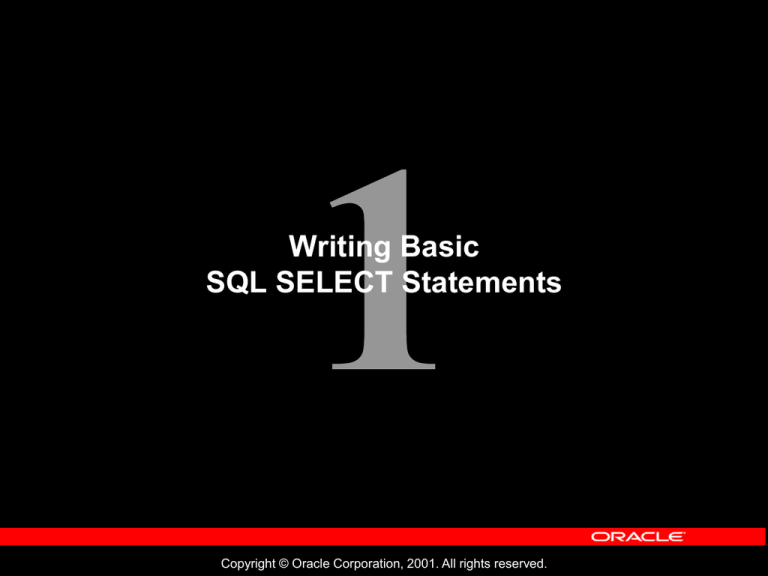
Writing Basic
SQL SELECT Statements
Copyright © Oracle Corporation, 2001. All rights reserved.
Capabilities of SQL SELECT Statements
Projection
Selection
Table 1
Table 1
Join
Table 1
1-2
Table 2
Copyright © Oracle Corporation, 2001. All rights reserved.
Basic SELECT Statement
SELECT
FROM
•
•
1-3
*|{[DISTINCT] column|expression [alias],...}
table;
SELECT identifies what columns
FROM identifies which table
Copyright © Oracle Corporation, 2001. All rights reserved.
Selecting All Columns
SELECT *
FROM
departments;
1-4
Copyright © Oracle Corporation, 2001. All rights reserved.
Selecting Specific Columns
SELECT department_id, location_id
FROM
departments;
1-5
Copyright © Oracle Corporation, 2001. All rights reserved.
Writing SQL Statements
1-6
•
•
•
SQL statements are not case sensitive.
•
Indents are used to enhance readability.
SQL statements can be on one or more lines.
Keywords cannot be abbreviated or split
across lines.
Copyright © Oracle Corporation, 2001. All rights reserved.
Column Heading Defaults
•
•
1-7
iSQL*Plus:
–
Default heading justification: Center
–
Default heading display: Uppercase
SQL*Plus:
–
Character and Date column headings are leftjustified
–
Number column headings are right-justified
–
Default heading display: Uppercase
Copyright © Oracle Corporation, 2001. All rights reserved.
Arithmetic Expressions
Create expressions with number and date data by
using arithmetic operators.
Operator
1-8
Description
+
Add
-
Subtract
*
Multiply
/
Divide
Copyright © Oracle Corporation, 2001. All rights reserved.
Using Arithmetic Operators
SELECT last_name, salary, salary + 300
FROM
employees;
…
1-9
Copyright © Oracle Corporation, 2001. All rights reserved.
Operator Precedence
* / +
1-10
_
•
Multiplication and division take priority over
addition and subtraction.
•
Operators of the same priority are evaluated from
left to right.
•
Parentheses are used to force prioritized
evaluation and to clarify statements.
Copyright © Oracle Corporation, 2001. All rights reserved.
Operator Precedence
SELECT last_name, salary, 12*salary+100
FROM
employees;
…
1-11
Copyright © Oracle Corporation, 2001. All rights reserved.
Using Parentheses
SELECT last_name, salary, 12*(salary+100)
FROM
employees;
…
1-12
Copyright © Oracle Corporation, 2001. All rights reserved.
Defining a Null Value
•
A null is a value that is unavailable, unassigned,
unknown, or inapplicable.
•
A null is not the same as zero or a blank space.
SELECT last_name, job_id, salary, commission_pct
FROM
employees;
…
…
1-13
Copyright © Oracle Corporation, 2001. All rights reserved.
Null Values
in Arithmetic Expressions
Arithmetic expressions containing a null value
evaluate to null.
SELECT last_name, 12*salary*commission_pct
FROM
employees;
…
…
1-14
Copyright © Oracle Corporation, 2001. All rights reserved.
Defining a Column Alias
A column alias:
• Renames a column heading
• Is useful with calculations
• Immediately follows the column name - there can
also be the optional AS keyword between the
column name and alias
•
1-15
Requires double quotation marks if it contains
spaces or special characters or is case sensitive
Copyright © Oracle Corporation, 2001. All rights reserved.
Using Column Aliases
SELECT last_name AS name, commission_pct comm
FROM
employees;
…
SELECT last_name "Name", salary*12 "Annual Salary"
FROM
employees;
…
1-16
Copyright © Oracle Corporation, 2001. All rights reserved.
Concatenation Operator
A concatenation operator:
1-17
•
Concatenates columns or character strings to
other columns
•
•
Is represented by two vertical bars (||)
Creates a resultant column that is a character
expression
Copyright © Oracle Corporation, 2001. All rights reserved.
Using the Concatenation Operator
SELECT
FROM
last_name||job_id AS "Employees"
employees;
…
1-18
Copyright © Oracle Corporation, 2001. All rights reserved.
Literal Character Strings
1-19
•
A literal is a character, a number, or a date
included in the SELECT list.
•
Date and character literal values must be enclosed
within single quotation marks.
•
Each character string is output once for each
row returned.
Copyright © Oracle Corporation, 2001. All rights reserved.
Using Literal Character Strings
SELECT last_name ||' is a '||job_id
AS "Employee Details"
FROM
employees;
…
1-20
Copyright © Oracle Corporation, 2001. All rights reserved.
Duplicate Rows
The default display of queries is all rows, including
duplicate rows.
SELECT department_id
FROM
employees;
…
1-21
Copyright © Oracle Corporation, 2001. All rights reserved.
Eliminating Duplicate Rows
Eliminate duplicate rows by using the DISTINCT
keyword in the SELECT clause.
SELECT DISTINCT department_id
FROM
employees;
1-22
Copyright © Oracle Corporation, 2001. All rights reserved.
Displaying Table Structure
Use the iSQL*Plus DESCRIBE command to display
the structure of a table.
DESC[RIBE] tablename
1-23
Copyright © Oracle Corporation, 2001. All rights reserved.
Displaying Table Structure
DESCRIBE employees
1-24
Copyright © Oracle Corporation, 2001. All rights reserved.
Restricting and Sorting Data
Copyright © Oracle Corporation, 2001. All rights reserved.
Limiting Rows Using a Selection
EMPLOYEES
…
“retrieve all
employees
in department 90”
1-26
Copyright © Oracle Corporation, 2001. All rights reserved.
Limiting the Rows Selected
•
Restrict the rows returned by using the WHERE
clause.
SELECT
FROM
[WHERE
•
1-27
*|{[DISTINCT] column|expression [alias],...}
table
condition(s)];
The WHERE clause follows the FROM clause.
Copyright © Oracle Corporation, 2001. All rights reserved.
Using the WHERE Clause
SELECT employee_id, last_name, job_id, department_id
FROM
employees
WHERE department_id = 90 ;
1-28
Copyright © Oracle Corporation, 2001. All rights reserved.
Character Strings and Dates
•
Character strings and date values are enclosed in
single quotation marks.
•
Character values are case sensitive, and date
values are format sensitive.
•
The default date format is DD-MON-YY.
SELECT last_name, job_id, department_id
FROM
employees
WHERE last_name = 'Whalen';
1-29
Copyright © Oracle Corporation, 2001. All rights reserved.
Comparison Conditions
Operator
1-30
Meaning
=
Equal to
>
Greater than
>=
Greater than or equal to
<
Less than
<=
Less than or equal to
<>
Not equal to
Copyright © Oracle Corporation, 2001. All rights reserved.
Using Comparison Conditions
SELECT last_name, salary
FROM
employees
WHERE salary <= 3000;
1-31
Copyright © Oracle Corporation, 2001. All rights reserved.
Other Comparison Conditions
1-32
Operator
Meaning
BETWEEN
...AND...
Between two values (inclusive),
IN(set)
Match any of a list of values
LIKE
Match a character pattern
IS NULL
Is a null value
Copyright © Oracle Corporation, 2001. All rights reserved.
Using the BETWEEN Condition
Use the BETWEEN condition to display rows based on
a range of values.
SELECT last_name, salary
FROM
employees
WHERE salary BETWEEN 2500 AND 3500;
Lower limit
1-33
Upper limit
Copyright © Oracle Corporation, 2001. All rights reserved.
Using the IN Condition
Use the IN membership condition to test for values in
a list.
SELECT employee_id, last_name, salary, manager_id
FROM
employees
WHERE manager_id IN (100, 101, 201);
1-34
Copyright © Oracle Corporation, 2001. All rights reserved.
Using the LIKE Condition
•
Use the LIKE condition to perform wildcard
searches of valid search string values.
•
Search conditions can contain either literal
characters or numbers:
– % denotes zero or many characters.
– _ denotes one character.
SELECT
FROM
WHERE
1-35
first_name
employees
first_name LIKE 'S%';
Copyright © Oracle Corporation, 2001. All rights reserved.
Using the LIKE Condition
•
You can combine pattern-matching characters.
SELECT last_name
FROM
employees
WHERE last_name LIKE '_o%';
•
1-36
You can use the ESCAPE identifier to search for the
actual % and _ symbols.
Copyright © Oracle Corporation, 2001. All rights reserved.
Using the NULL Conditions
Test for nulls with the IS NULL operator.
SELECT last_name, manager_id
FROM
employees
WHERE manager_id IS NULL;
1-37
Copyright © Oracle Corporation, 2001. All rights reserved.
Logical Conditions
1-38
Operator
Meaning
AND
Returns TRUE if both component
conditions are true
OR
Returns TRUE if either component
condition is true
NOT
Returns TRUE if the following
condition is false
Copyright © Oracle Corporation, 2001. All rights reserved.
Using the AND Operator
AND requires both conditions to be true.
SELECT
FROM
WHERE
AND
1-39
employee_id, last_name, job_id, salary
employees
salary >=10000
job_id LIKE '%MAN%';
Copyright © Oracle Corporation, 2001. All rights reserved.
Using the OR Operator
OR requires either condition to be true.
SELECT
FROM
WHERE
OR
1-40
employee_id, last_name, job_id, salary
employees
salary >= 10000
job_id LIKE '%MAN%';
Copyright © Oracle Corporation, 2001. All rights reserved.
Using the NOT Operator
SELECT last_name, job_id
FROM
employees
WHERE job_id
NOT IN ('IT_PROG', 'ST_CLERK', 'SA_REP');
1-41
Copyright © Oracle Corporation, 2001. All rights reserved.
Rules of Precedence
Order Evaluated
1
2
3
4
5
6
7
8
Operator
Arithmetic operators
Concatenation operator
Comparison conditions
IS [NOT] NULL, LIKE, [NOT] IN
[NOT] BETWEEN
NOT logical condition
AND logical condition
OR logical condition
Override rules of precedence by using parentheses.
1-42
Copyright © Oracle Corporation, 2001. All rights reserved.
Rules of Precedence
SELECT
FROM
WHERE
OR
AND
1-43
last_name, job_id, salary
employees
job_id = 'SA_REP'
job_id = 'AD_PRES'
salary > 15000;
Copyright © Oracle Corporation, 2001. All rights reserved.
Rules of Precedence
Use parentheses to force priority.
SELECT
FROM
WHERE
OR
AND
1-44
last_name, job_id, salary
employees
(job_id = 'SA_REP'
job_id = 'AD_PRES')
salary > 15000;
Copyright © Oracle Corporation, 2001. All rights reserved.
ORDER BY Clause
•
•
Sort rows with the ORDER BY clause
–
ASC: ascending order, default
–
DESC: descending order
The ORDER BY clause comes last in the SELECT
statement.
SELECT
last_name, job_id, department_id, hire_date
FROM
employees
ORDER BY hire_date ;
…
1-45
Copyright © Oracle Corporation, 2001. All rights reserved.
Sorting in Descending Order
SELECT
last_name, job_id, department_id, hire_date
FROM
employees
ORDER BY hire_date DESC ;
…
1-46
Copyright © Oracle Corporation, 2001. All rights reserved.
Sorting by Column Alias
SELECT employee_id, last_name, salary*12 annsal
FROM
employees
ORDER BY annsal;
…
1-47
Copyright © Oracle Corporation, 2001. All rights reserved.
Summary
In this lesson, you should have learned how to:
•
•
Use the WHERE clause to restrict rows of output
–
Use the comparison conditions
–
Use the BETWEEN, IN, LIKE, and NULL conditions
–
Apply the logical AND, OR, and NOT operators
Use the ORDER BY clause to sort rows of output
SELECT
FROM
[WHERE
[ORDER BY
1-48
*|{[DISTINCT] column|expression [alias],...}
table
condition(s)]
{column, expr, alias} [ASC|DESC]];
Copyright © Oracle Corporation, 2001. All rights reserved.





